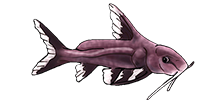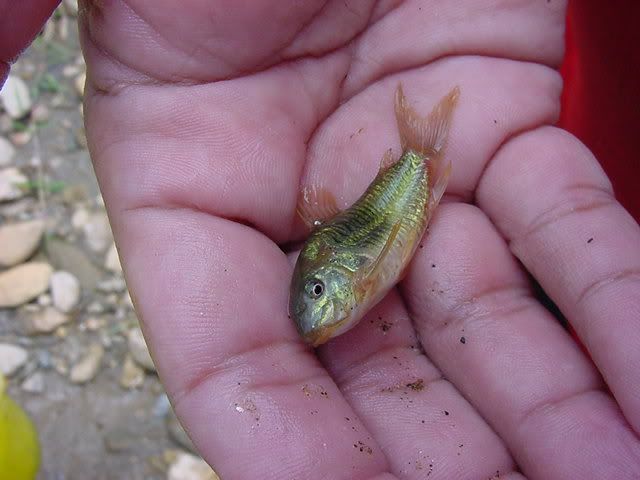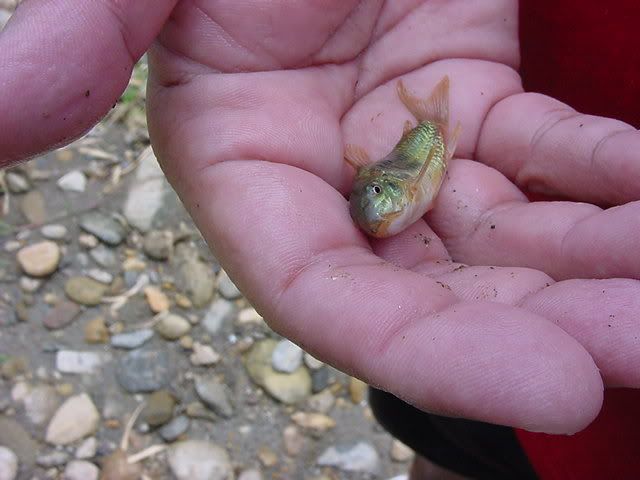Corydoras aeneus black Venezuela
Corydoras aeneus black Venezuela
Dear friends.
There is a discussion going on over here.
Can someone tell me the difference of the so called wild caught Corydoras aeneus Black Venezuela from the area of Llanos, and the so callad Corydoras sp. Black based on the breading of C. Schultzei. Much coming from breaders in Check rep.
And are there other "black" types.
Also interested if someone have pictures that can show the difference.
Kind regards Jon in Norway.
There is a discussion going on over here.
Can someone tell me the difference of the so called wild caught Corydoras aeneus Black Venezuela from the area of Llanos, and the so callad Corydoras sp. Black based on the breading of C. Schultzei. Much coming from breaders in Check rep.
And are there other "black" types.
Also interested if someone have pictures that can show the difference.
Kind regards Jon in Norway.
A living room without floor drain?
-
Coryologist
- Posts: 561
- Joined: 09 Nov 2003, 13:10
- I've donated: $200.00!
- My images: 11
- My cats species list: 70 (i:0, k:0)
- Spotted: 5
- Location 1: Laurel Lake, NJ
- Location 2: Laurel Lake, NJ
- Interests: Fancy Guppies, Cory Cats, Digital Photography, DV, Triumph Motorcycles
Re: Corydoras aeneus black Venezuela
Greetings. I have been informed that there is no such fish in existence, if I correctly understand what was explained to me.josti wrote:Dear friends. There is a discussion going on over here.
Can someone tell me the difference of the so called wild caught Corydoras aeneus Black Venezuela from the area of Llanos,
I can only offer an image of the latter. - Frankand the so callad Corydoras sp. Black based on the breading of C. Schultzei. Much coming from breaders in Check rep.
And are there other "black" types.
Also interested if someone have pictures that can show the difference.
Kind regards Jon in Norway.

Thank you Frank,
The one you have there looks very much like mine.
But here on PC I find a description of the “black” from Llanos:
“This species is common throughout the lower reaches of streams and rivers in both the Rio Tuy and Lake Valencia drainages of northern Venezuela in the states of Miranda, Aragua, and Carabobo. It can also be found in nearby Orinoco drainage rivers and streams such as the Rio Chirgua. It is a piedmont species that prefers cooler waters and is never found in the llanos (plains). In the llanos it is replaced by C. venezuelanus ''black'' which may be a morph or subspecies of C. venezuelanus. “
But I find no pictures.
To me this is, as a lot of other Cory things, kind of confusing.
Jon in Norway
[Mod edit: use persistant link to Cat-eLog. - and turn back on BBCode]
The one you have there looks very much like mine.
But here on PC I find a description of the “black” from Llanos:
“This species is common throughout the lower reaches of streams and rivers in both the Rio Tuy and Lake Valencia drainages of northern Venezuela in the states of Miranda, Aragua, and Carabobo. It can also be found in nearby Orinoco drainage rivers and streams such as the Rio Chirgua. It is a piedmont species that prefers cooler waters and is never found in the llanos (plains). In the llanos it is replaced by C. venezuelanus ''black'' which may be a morph or subspecies of C. venezuelanus. “
But I find no pictures.
To me this is, as a lot of other Cory things, kind of confusing.
Jon in Norway
[Mod edit: use persistant link to Cat-eLog. - and turn back on BBCode]
A living room without floor drain?
- Kostas
- Posts: 791
- Joined: 23 Apr 2003, 10:57
- I've donated: $256.00!
- My images: 19
- My cats species list: 14 (i:0, k:0)
- My aquaria list: 1 (i:1)
- Spotted: 6
- Location 1: Greece,Athens
- Location 2: Greece,Athens
- Interests: Fishkeeping,diving,skiing,r/c modeling,growing Palm trees,ferns and tropical plants
- Contact:
Wild caught C. venelueliannus ''black'' do exist...But they are not solid black as one would expect...
Here is a photo of a wild caught C. venezuelanus ''black''

There has been an extensive discussion on that in the past,for more info see this thread...
Here is a photo of a wild caught C. venezuelanus ''black''

There has been an extensive discussion on that in the past,for more info see this thread...
C.aneues Black were line bred in the CR from true C.schwartzi until they got as black a cory as they possibly could. They will NOT be found in the wild at all, unless someone has actually added them to the wild LOL.
As for the C.venezulans, the black bit seems to have been added onto the end by wholesalers. Obviously as you can see there is very very little black in them so its confusing as to why they added this LOL.
Hope that helps.
As for the C.venezulans, the black bit seems to have been added onto the end by wholesalers. Obviously as you can see there is very very little black in them so its confusing as to why they added this LOL.
Hope that helps.
This is a messy discussion. First, there exists nothing like CORYDORAS VENEZUELANUS "BLACK". The fish on the picture is simply CORYDORAS VENEZUELANUS.
Corydoras sp. Venezuela Black is a black fish resembling Corydoras aeneus, but with a black-violet body and violet-red fins when viewed against the sun or under an intensive light. It is a relatively new fish in Czech republic and is currently bred on a mass scale due to huge demand abroad. The upper picture is a typical sp. Venezuela Black.
The origin of this fish is not clear to me. Several months ago I saw them at a breeder in Prague, and I eventually decided to buy them, because I was impressed by their colouring. Yet in the meantime, I discussed with another breeder, who told me that he had big adult fish of the same species, so I decided to prefer adults instead of little fish. He also told me that these fish are not a natural species, but a genetic variation of Corydoras aeneus that was "made" by an East German breeder a long time ago.
However, the fish that he sent me were a big disappointment for me: They differed markedly from the nice "Blacks", especially in body form, and I was really so disgusted by them that I almost immediately sold them to a nearby shop. Basically, they were too large for me, and their body was so long that they resembled a slimy black eel.
Now I have the nicer Blacks from the Prague breeder. They haven't spawned yet, but they should spawn very soon.
Corydoras sp. Venezuela Black is a black fish resembling Corydoras aeneus, but with a black-violet body and violet-red fins when viewed against the sun or under an intensive light. It is a relatively new fish in Czech republic and is currently bred on a mass scale due to huge demand abroad. The upper picture is a typical sp. Venezuela Black.
The origin of this fish is not clear to me. Several months ago I saw them at a breeder in Prague, and I eventually decided to buy them, because I was impressed by their colouring. Yet in the meantime, I discussed with another breeder, who told me that he had big adult fish of the same species, so I decided to prefer adults instead of little fish. He also told me that these fish are not a natural species, but a genetic variation of Corydoras aeneus that was "made" by an East German breeder a long time ago.
However, the fish that he sent me were a big disappointment for me: They differed markedly from the nice "Blacks", especially in body form, and I was really so disgusted by them that I almost immediately sold them to a nearby shop. Basically, they were too large for me, and their body was so long that they resembled a slimy black eel.
Now I have the nicer Blacks from the Prague breeder. They haven't spawned yet, but they should spawn very soon.
- Coryman
- Expert
- Posts: 2119
- Joined: 30 Dec 2002, 19:06
- My articles: 12
- My catfish: 5
- My cats species list: 83 (i:5, k:0)
- My BLogs: 1 (i:0, p:1)
- Spotted: 194
- Location 1: Kidderminster UK
- Location 2: Kidderminster, UK
- Interests: Cory's, Loricariids, photography and more Cory's
- Contact:
Corydoras aeneus Black (Venezuela)
This particular topic seems to raise it's head on a regular basis, so I will yet again try and put the record straight with the help of a statement from Hans-Gerog Evers
"I knew the guy who "created" the "black aeneus". His name was Hartmut Eberhardt. He lived in Weimar and was a dear friend of Dr. Hanns-Joachim Franke. Both were my friends and both are already dead and it seems, that some storys need to be retold. Hartmut had the very first black aeneus amongst his thousands of normally coloured ones of the "schultzei-type". The black ones have orange fins in the first months of their life and so does one type of aeneus from Venezuela. This type lives in the Llanos of Venezuela and also Colombia and is regularly being imported. When they darken their body colouration (stress, light, etc.) they resemble the black youngsters and this might have lead to the name Black aeneus from Venezuela".
I am sure it was Shane that told us about the dark form he found in Venezuela which resembled the so called C. venezuelanus in body shape.
I first bred the Black C. schultzii in 1998, these were part of my original stock.
Ian

Picture courtesy Ian Fuller & Corydorasworld.com
"I knew the guy who "created" the "black aeneus". His name was Hartmut Eberhardt. He lived in Weimar and was a dear friend of Dr. Hanns-Joachim Franke. Both were my friends and both are already dead and it seems, that some storys need to be retold. Hartmut had the very first black aeneus amongst his thousands of normally coloured ones of the "schultzei-type". The black ones have orange fins in the first months of their life and so does one type of aeneus from Venezuela. This type lives in the Llanos of Venezuela and also Colombia and is regularly being imported. When they darken their body colouration (stress, light, etc.) they resemble the black youngsters and this might have lead to the name Black aeneus from Venezuela".
I am sure it was Shane that told us about the dark form he found in Venezuela which resembled the so called C. venezuelanus in body shape.
I first bred the Black C. schultzii in 1998, these were part of my original stock.
Ian

Picture courtesy Ian Fuller & Corydorasworld.com
mmm which is what i said LOLcartouche wrote:This is a messy discussion. First, there exists nothing like CORYDORAS VENEZUELANUS "BLACK". The fish on the picture is simply CORYDORAS VENEZUELANUS.
There is no such named fish. The picture shown in Franks picture is known as C.aeneus Black.Corydoras sp. Venezuela Black is a black fish resembling Corydoras aeneus, but with a black-violet body and violet-red fins when viewed against the sun or under an intensive light. It is a relatively new fish in Czech republic and is currently bred on a mass scale due to huge demand abroad. The upper picture is a typical sp. Venezuela Black.
see Ians post which i have just noticed.The origin of this fish is not clear to me.
Good look with them. They are very much like C.aeneus Bronze and Albino in the number of eggs they produce. However, be aware that the young seem to be alot more sensitive to water conditions that other aeneus. Once they get past a couple of months old, losses do cease.
Now I have the nicer Blacks from the Prague breeder. They haven't spawned yet, but they should spawn very soon.
- Kostas
- Posts: 791
- Joined: 23 Apr 2003, 10:57
- I've donated: $256.00!
- My images: 19
- My cats species list: 14 (i:0, k:0)
- My aquaria list: 1 (i:1)
- Spotted: 6
- Location 1: Greece,Athens
- Location 2: Greece,Athens
- Interests: Fishkeeping,diving,skiing,r/c modeling,growing Palm trees,ferns and tropical plants
- Contact:
As you saw from Ian's comment, there really exist two different forms of these "blacks". One is an ugly genetic variant of Corydoras aeneus created in East Germany, and the second one is an import from Venezuela with a nicer body. Since the coloring of both these variants is similar, similar genes/mutations in the populations of Corydoras aeneus may stand behind their genesis.
The Venezuelan fish is normally called "Corydoras sp. Venezuela Black" in the Czech wholesale. The name "Corydoras aeneus Black" would be more appropriate for the East German eels.
The Venezuelan fish is normally called "Corydoras sp. Venezuela Black" in the Czech wholesale. The name "Corydoras aeneus Black" would be more appropriate for the East German eels.
-
syno321
- Posts: 246
- Joined: 26 Oct 2004, 04:03
- I've donated: $127.00!
- My articles: 2
- My cats species list: 33 (i:0, k:0)
- Location 1: Edmonton,Alberta, Canada
- Location 2: Edmonton, Alberta, Canada
beauty
"Beauty is in the eye of the beholder" I was entranced with these fish when a good friend of mine brought some back for me from Germany in 1992(?) He had purchased them at a "birza"(?)from a private breeder. I enjoyed them immensely and bred them for many generations. They are much harder to breed than typical aeneus, especially with respect to fecundity, fertility rates, fry mortality and inducing them to spawn. I had purchased some of the Czech "black aeneus", raised them to adulthood, and have had several spawns with no fertile eggs. After previous success with the German blacks, I'm a little frustrated with these fish and am running out of ideas with regard to the fertility problem. Any ideas?
Ask not...
- JoseAngelBarro
- Posts: 151
- Joined: 01 Mar 2005, 20:51
- My cats species list: 7 (i:0, k:0)
- Location 1: Valencia, Venezuela
- Contact:
-
Coryologist
- Posts: 561
- Joined: 09 Nov 2003, 13:10
- I've donated: $200.00!
- My images: 11
- My cats species list: 70 (i:0, k:0)
- Spotted: 5
- Location 1: Laurel Lake, NJ
- Location 2: Laurel Lake, NJ
- Interests: Fancy Guppies, Cory Cats, Digital Photography, DV, Triumph Motorcycles
Capyure
Looks like bog common C. venezuelanus, to me. Is that your opinion? - Frank
I used to be schizophrenic, but we're OK now. At least that's what my dog is always telling me!
Hear podcasts of "Sounds Fishy to Me," here: http://www.aquaradio.net
Hear podcasts of "Sounds Fishy to Me," here: http://www.aquaradio.net
- JoseAngelBarro
- Posts: 151
- Joined: 01 Mar 2005, 20:51
- My cats species list: 7 (i:0, k:0)
- Location 1: Valencia, Venezuela
- Contact:









